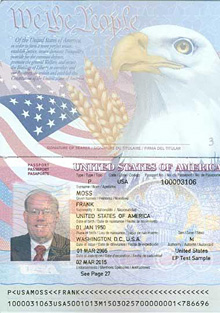 |
 |
 |
 Technology News | August 2006 Technology News | August 2006  
Passports Go High-Tech
 Kirit Radia - ABC News Kirit Radia - ABC News


| | With computer chips and antennas, new passports bring more security, government says. |
The US State Department this week rolled out the next generation of U.S. passports. The new electronic passports (e-passports) contain a small computer chip and antenna in the corner of the back cover that the government says will not only speed up lines at ports of entry, but will also make the passports more secure and harder to counterfeit.

The new passport will look almost the same from the outside, keeping the traditional blue covers with gold insignia, but it will also have a small icon on the cover that is the international symbol for an e-passport.

The passports are also slightly thicker than the previous ones and the page designs and layout will be different than before, all of which the State Department says are part of the increased security in the new design.

Personal information will now be located on the second page of the passport, rather than on the inside cover as it was before, and pages will feature raised lettering and watermarks.

The computer chip in the passport will provide an extra layer of identification to protect against counterfeiting. In order to read the chip, the passport must be swiped or scanned manually, as the old passports are now, to activate the chip. The passport is then waved over a reader that verifies that the information on the chip is authentic and consistent with the information printed on the passport.

These new passports will be available first only for those applications processed at the Denver, Colo., passport office.

The State Department hopes to expand production of the new e-passports to more passport offices over the coming months, with the goal of all new passports being e-passports by the end of 2007.

Since passports are valid for up to 10 years, State Department officials say they hope that by 2017 all U.S. passports in circulation will be e-passports.

Some people, however, are concerned that the new passports will be more vulnerable to identity theft, hacking, and manipulation. The computer chips will contain personal information, such as name, birthdate, and a digital photograph of the bearer.

Privacy groups worry that this information could be stolen electronically.

Some are concerned that the new passports will be more vulnerable to identity theft, hacking, and manipulation. A July 28, 2006, letter to the Department of Homeland Security from the American Civil Liberties Union says the technology creates "serious security and privacy risks that have not been adequately addressed by proponents of the technology."

The State Department counters that special unique identification numbers are needed to access that data, so it cannot be read by identity thieves.

"There are a number of overlapping redundant security features to the passport," State Department spokesman Sean McCormack said today.

The new passports will also feature a thin metallic shield in the cover that will prevent the passport from being read by any device while the book is closed. This is to prevent thieves from reading the data on the chip without the owner's knowledge.

The chip will not have any information specifically identifying it as a U.S. passport, so outside scanners would not be able to distinguish it from other devices that features similar chips, such as some credit cards.

Furthermore, State Department officials say the information cannot be written on a chip and it will not contain travel history that could track a travelers' movement. A person's travel history is not logged in any database.

"I am told the information contained on that chip is no more extensive than you would find on the inside flap written down on that passport," one official said.

Others worry that counterfeiters and terrorists will be able to copy information from one passport to another, or alter the information on an existing passport. The State Department refutes that possibility as well, saying that the digital signature technology employed in the new passports would indicate if information has been added, tampered with, or copied from one chip to another -- setting off a red flag for a customs officer at a port of entry.

Other countries have begun to employ this technology as well. Japan, Singapore, Sweden, Australia, and the United Kingdom have all started to issue e-passports. Since not all ports of entry in the United States or around the world will be able to read the new chips yet, the new passports can still be scanned as the old ones are today.

Similarly, if the chip is somehow broken, the new passports could be scanned just as the old ones are today. State Department officials say that they have done extensive durability testing on the new passports, and they are confident that the new documents would be able to withstand normal use and abuse.

They warn, however, that putting the new passport in the microwave could destroy the data on the computer chip.

In 2005 the | 
 | |
 |



